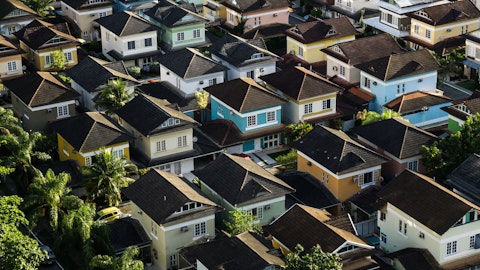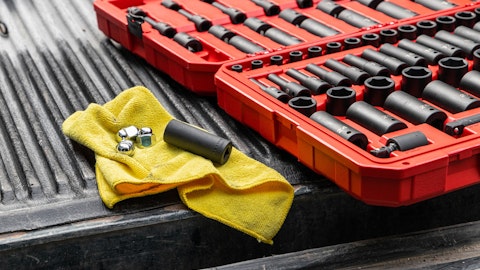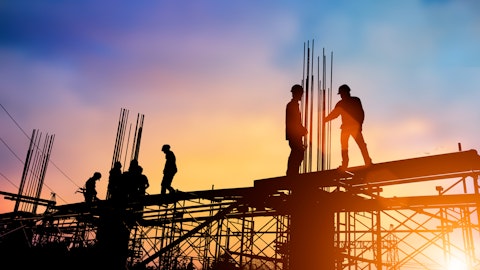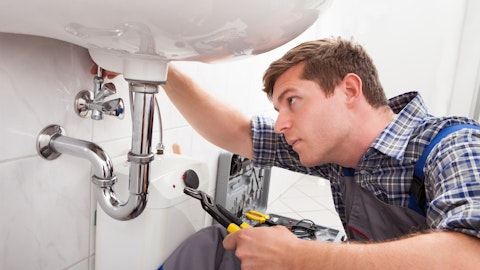Masco Corporation (NYSE:MAS) Q4 2022 Earnings Call Transcript February 9, 2023
Operator: Good morning, ladies and gentlemen. Welcome to Masco Corporation’s Fourth Quarter and Full Year Conference Call. My name is Emily, and I’ll be your operator for today’s call. As a reminder, today’s conference call is being recorded for replay purposes. I will now turn the call over to David Chaika, Vice President, Treasurer and Investor Relations. You may begin.
David Chaika: Thank you, Emily, and good morning. Welcome to Masco Corporation’s 2022 fourth quarter and full year conference call. With me today are Keith Allman, President and CEO of Masco; and John Sznewajs, Masco’s Vice President and Chief Financial Officer. Our fourth quarter earnings release and the presentation slides are available on our website under Investor Relations. Following our remarks, we will open the call for analyst questions. Please limit yourself to one question with one follow-up. If we can’t take your question now, please call me directly at 313-792-5500. Our statements today will include our views about our future performance, which constitute forward-looking statements. These statements are subject to risks and uncertainties that could cause our actual results to differ materially from the forward-looking statements.
We describe these risks and uncertainties in our Risk Factors and other disclosures in our Form 10-K and our Form 10-Q that we filed with the Securities and Exchange Commission. Our statements will also include non-GAAP financial metrics. Our references to operating profit and earnings per share will be as adjusted, unless otherwise noted. We reconcile these adjusted metrics to GAAP in our earnings release and presentation slides, which are available on our website under Investor Relations. With that, I’ll now turn the call over to Keith.
Keith Allman: Thank you, Dave. Good morning, everyone, and thank you for joining us today. I’ll start this morning with some brief comments on our fourth quarter, and I’ll turn to our full year results and our view on 2023. Before I get started, however, I’m sure you saw our announcement that John Sznewajs has decided to retire from Masco, effective at the end of May, and we are working to identify his replacement. John has been a fixture at Masco and in the industry for over 25 years now, and has been an invaluable partner to me, our Board and the investment community during his 15-year tenure as CFO of our company. He will be sorely missed, and we wish John all the best in his future endeavors. Now please turn to Slide 5. In the fourth quarter, our top-line decreased 5%, as we saw lower volumes across most categories, partially offset by significant pricing actions of 9%.
Our operating profit declined in the quarter due to the lower volumes, higher operational costs and currency. This was partially offset by pricing actions and expense control as SG&A declined $22 million to 17.4% of sales. Our earnings per share for the quarter were $0.65. Earnings per share benefited from a lower average diluted share count as well as effective tax rate of 24%, lower than our previously guided 25%. Turning to our segments. Plumbing grew 2% in local currency with a 1% decline in North American Plumbing, offset by 7% growth in International Plumbing. Hansgrohe drove market share gains in many key markets, including China, Germany and France. Our International business has continued to execute well, which speaks to the strength of the Hansgrohe team, its strong brands and its ability to gain market share.
In North America, our spa business has now worked through its extended backlog and backlogs are now in the normal range of four to six weeks after a tremendous three-year run of more than 50% sales growth. Turning to our Decorative Architectural segment. Sales declined 8% against a strong 15% comp. DIY paint sales declined low double digits, while PRO paint continued its excellent performance with mid-single digit growth against a tremendous comp of over 50%. Now let’s review our full-year performance. Please turn to Slide 6. 2022 was a challenging year with strong growth in the first half followed by notable declines in demand in the second half. Despite these volatile conditions, Masco and our 19,000 employees across the globe responded well to deliver for our customers and our shareholders.
For the full year, the company grew sales 4% for a two-year stacked comp of 21%. Strong pricing actions increased sales by 9%, offset by volume declines of 3% and currency impact of 2%. Volume growth in the first half of the year was more than offset by volume declines in the second half. Operating profit declined 7% with an operating margin of 15.6%, and earnings per share increased from $3.77 — to $3.77 from $3.70. Total commodity and other inflation was low double digits for the full year. This inflation, together with supply chain challenges, resulted in lower margins for the year despite our significant pricing actions. We are focused on improving our margins by continuing to drive productivity as we apply our 80/20 mindset to return to our pre-pandemic levels.
Turning to our segments. Our Plumbing segment grew 6% excluding currency, led by strong growth at both Hansgrohe and Watkins. In our Decorative Architectural segment, full year growth was 6%. DIY paint grew low single digits for the year, while PRO paint grew over 25%. PRO paint has had a tremendous three-year run of approximately 70% growth, and now accounts for one-third of our paint business or over $900 million. This strong performance earned Behr its second consecutive Partner of the Year Award for the Home Depot. We will continue to invest in our paint business to capture further share in both the DIY and PRO markets. Our recently launched adjacent paint categories such as aerosols, interior stains and caulks and sealants have performed well and are expanding the offering to additional stores and expect further share gains in 2023.
We will be launching Behr Dynasty Exterior for the summer painting season, expanding the lineup of our number one rated Dynasty paint line. And we will continue to invest in people and capabilities to better serve the PRO painter and continue our strong PRO performance. Turning to capital allocation. Our strong balance sheet allowed us to deploy approximately $1.2 billion in capital during the year. We repurchased 16.6 million shares for $914 million, representing approximately 7% of our outstanding shares. We increased our quarterly dividend 19% and paid $258 million in dividends to shareholders. And we finished the year with net leverage of 1.8 times, providing us ample financial flexibility. Our balanced, disciplined approach to capital allocation and strong cash flow resulted in a return on invested capital of approximately 39%.
Lastly, on the ESG front, we believe our business should be part of the solution to the world’s climate crisis. Therefore, we have established a target to reduce our emissions by 50% by the year 2030, aligned with science-based targets. This is consistent with our commitment to doing business the right way and our purpose to provide better living possibilities for homes, our environment and our community. I want to thank all our employees for their outstanding efforts throughout 2022. It is a team effort to continue to deliver for our customers and shareholders. Now, turning to 2023. We expect the softening demand trends in the second half of 2022 to continue into 2023 as our markets adjust to increasing interest rates, persistent inflation and tighter consumer spending.
Overall, we anticipate volumes to decline in the low double digit range, offset, to a small extent, by pricing actions. Our current market assumptions for 2023 are as follows. For the North American repair and remodel market, we expect the market to be down approximately low double digits. This is after a very strong three-year run of approximately 20% growth. For the paint market, we expect the DIY paint market to be down high-single digits and the PRO market to decline by mid-single digits. And for our International markets, principally Europe, we expect markets to contract by high-single digits. As a result, we anticipate Masco sales in 2023 to decline approximately 10%. With this lower top-line assumption, we will drive to minimize our decremental margins to be in the low 20% range versus our typical 30% decremental margins.
We are focused on recovering the significant cost inflation we experienced over the past two years through operational productivity, supply chain normalization and additional pricing actions. With this focus, we expect our operating margin to be approximately 15% in 2023. Turning to capital allocation. Our strategy remains unchanged. First and foremost, we will invest in our business to maintain and grow our leadership positions and win in the recovery. The second pillar of our capital allocation strategy is to maintain a strong balance sheet with gross debt to EBITDA levels of below 2.5 times. Third, we have a targeted dividend payout ratio of 30%. Our Board declared a 2% increase in our dividend for 2023, which will bring our annual dividend to $1.14 per share and marks the tenth consecutive annual increase.
We expect our cash flow conversion to be over 100% in 2023, as we manage our working capital. We will deploy that free cash flow after dividends to share repurchases or acquisitions. Based on our projected free cash flow, we expect to deploy approximately $500 million to share repurchases or acquisitions in 2023, in addition to paying the remaining $200 million of our term loan. Lastly, there is no change to our M&A strategy. We continue to review and selectively pursue opportunities that have the right strategic fit and the right return for Masco. With the actions we are taking to address this more challenging environment, coupled with our continued strong capital deployment, we anticipate earnings per share for 2023 to be in the range of $3.10 to $3.40 per share.
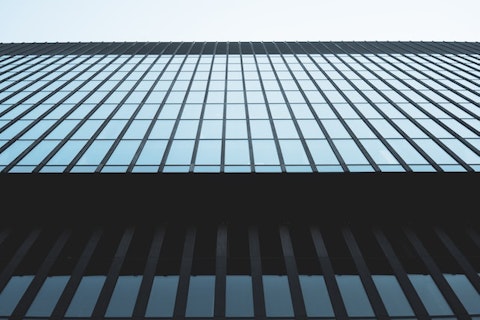
Photo by Self Taught on Unsplash
While we expect the near-term environment will remain challenging as our markets and the economy adjust to higher interest rates and prices, we believe the long-term fundamentals of our repair and remodel markets are strong. Cyclical factors such as home price appreciation and existing turnover will remain challenged and likely a headwind for 2023. However, structural factors, such as consumers staying in their homes longer, the age of housing stock and high home equity levels will drive increased repair and remodel activity in several ways. Many homeowners have taken advantage of low mortgage rates and are likely to remain in their homes longer. 1.5 million more homes will reach the prime remodeling ages of 20 to 39 years old over the next three years.
And home equity levels remain high and can withstand significant pullbacks in home prices and still be above 2019 levels. All of these structural forces provide tailwinds for our business and increase our confidence for a strong repair and remodel market after the economy stabilizes in 2023. We will continue to invest in our brands, capabilities and people to outperform the composition in both the near and the long term. With favorable fundamentals and our continued focus on executing our growth strategy, together with our strong free cash flow and capital deployment, we are positioned to continue to drive shareholder value creation for the long term. Now, I’ll turn the call over to John to go over our fourth quarter, full year and ’23 outlook in more detail.
John?
John Sznewajs: Thank you, Keith, and good morning, everyone. Before I begin my comments, I want to take a moment to thank Keith, our Board and the entire Masco organization for the opportunity to serve as CFO for more than 15 years. I’ve had an amazing and fulfilling 27-year career with company. As I look forward to my retirement, I wish everyone the best. With that, as Dave mentioned, my comments today will focus on adjusted performance, excluding the impact of rationalization and other one-time items. Turning to Slide 8. Sales in the quarter decreased 5% and, excluding currency, decreased 2%. Lower volumes decreased sales by 11%, partially offset by net selling prices, which increased sales by 9%. In local currency, North American sales decreased 5%.
Lower volume decreased sales by 14%, partially offset by higher net selling prices, which increased sales by 10%. In local currency, International sales increased 7%, driven by increased selling prices. As it relates to inventory, we believe channel inventories have stabilized as we saw sell-through approximately equal to sell-in and destocking had minimal impact in the quarter. Our gross margin of 29.5% was impacted by lower volumes, and higher year-over-year operational costs in the quarter. Our SG&A as a percentage of sales improved 20 basis points to 17.4% through continued cost discipline. Our operating profit in the fourth quarter was $234 million and operating margin was 12.2%. Operating profit was impacted by lower volumes, higher operational costs and currency, partially offset by higher net selling prices.
Lastly, our EPS in the quarter was $0.65. I would like to note that this performance was based on a tax rate of 24% versus the previously guided 25% tax rate due to the implementation of our tax planning strategies. Because of this assumption, we have provided restated adjusted EPS numbers for the first three quarters of 2022 in the appendix on Slide 28. Turning to the full year 2022. Sales increased 4% over prior year against a healthy comp of 17% for full year 2021. Excluding currency, sales increased 6%. Higher net selling prices increased sales by 9%, partially offset by lower volumes, which decreased sales by 3%. In local currency, North American sales increased 6% and the International sales increased 8%. Our SG&A as a percent of sales decreased 90 basis points to 16%.
Operating profit for the full year was $1.4 billion and operating margin was 15.6%. Lastly, our EPS increased 2% to $3.77. This amount also assumes a tax rate of 24% versus a previously guided 25%, which favorably impacted full year EPS by $0.05. Our adjusted EPS calculation for 2023 will continue to assume a 24% tax rate. I want to thank our employees across the globe for their hard work and dedication to achieve these solid results during a challenging year. Turning to Slide 9. Plumbing sales in the quarter decreased 3%. Excluding the impact of currency, sales grew 2%. Pricing contributed 9% to growth and volume decreased sales by 7%. North American Plumbing sales decreased 1% in local currency. This was driven by lower demand we started to experience in the third quarter.
Lower demand was fairly broad based across product categories and channels. International Plumbing sales increased 7% in local currency. Hansgrohe grew sales in many of their key markets, most notably China, Germany and France. Segment operating profit in the fourth quarter was $148 million and operating margin was 12.4%. Operating profit was impacted by lower volumes, higher operational costs and currency, partially offset by higher net selling prices. Turning to the full year 2022, Plumbing sales increased 2%. Excluding currency, sales increased 6% with net selling prices contributing 7% to growth, partially offset by lower volume mix, which decreased sales by 1%. In local currency, North American Plumbing sales grew 5% and International Plumbing sales increased 8%.
Full year operating profit was $834 million, with an operating margin of 15.9%. Turning to Slide 10. Decorative Architectural sales decreased 8% for the fourth quarter against a 15% comp. Our PRO paint sales increased mid-single digits against a robust comp of over 50% in the fourth quarter 2021, as we continue to see solid demand for our PRO paint offering, strong brands and high-quality products. Our DIY paint sales declined low double digits versus prior year. Additionally, our lighting and builders’ hardware businesses, in aggregate, declined mid-teens in the quarter against a solid mid-single digit comp. Operating profit was $101 million in the quarter and operating margin was 13.9%. Operating profit was impacted by lower volumes and higher material costs, partially offset by higher net selling prices.
Turning to the full year 2022, sales increased 6%, driven by low single digit growth in our DIY paint business and outstanding PRO paint growth of over 25%. Full year operating income was $608 million and operating margin was 17.7%. Turning to Slide 11. Our year-end balance sheet is strong with net debt to EBITDA at 1.8 times. We ended the quarter with approximately $1.5 billion of balance sheet liquidity, which includes full availability of our $1 billion revolver. Working capital as a percent of sales was 17.4% at year-end. In 2023, with expected lower volumes and less supply chain disruptions, we anticipate working capital as a percent of sales to improve and be approximately 16.5% at year-end. In 2022, we also paid down $300 million of the $500 million term loan that we borrowed in the second quarter of the year.
Finally, during 2022, we repurchased 16.6 million shares for $914 million and returned $258 million to shareholders through dividends. Now, let’s turn to Slide 12 and review our outlook for 2023. I’d like to preface our guidance by reminding everyone that these are uncertain times, which makes forecasting extremely challenging. For Masco overall, we are planning for volumes to be down in the low double digit range, partially offset by low single digit pricing. Based on this assumption, we expect 2023 sales to decline approximately 10%, with operating margins of approximately 15%. Currency is projected to have minimal impact on our 2023 results. Our SG&A as a percentage of sales trended below our normal levels during the pandemic. However, as we continue to invest in our businesses for future growth while maintaining cost discipline, we expect this percentage to increase back to a more normalized pre-pandemic level to be around 17.5% for 2023.
As always, we will take appropriate actions to address our costs as the year develops based on market conditions. Operating margins will be impacted more in the first half of the year due to lower volumes and strong year-over-year sales comps, particularly in the Decorative Architectural segment. As we previously discussed, operating profit in the first quarter will also be impacted by the higher operational costs we experienced starting in Q2 last year, particularly in the Plumbing segment. As we think about the cadence for the year, we expect our Q1 sales and margin profile to look similar Q4 2022 with our year-over-year operating margins expanding — expected to improve each quarter thereafter. In our Plumbing segment, we expect 2023 sales to decline in the range of 10% to 14%.
We anticipate the full year Plumbing margins will be roughly flat with 2022 segment margins at approximately 16%. Lower volumes and, in the first quarter, higher operational costs will impact margins, with favorable selling price increases partially offsetting these headwinds. In our Decorative Architectural segment, we expect 2023 sales to decline in the range of 5% to 10%. Looking specifically at paint for 2023, we currently anticipate our DIY business to decrease high-single digits and our PRO business to decrease mid-single digits, as we cycle over 25% PRO paint growth in 2022. We anticipate the full year Decorative Architectural margin to be approximately 16%. This margin is largely due to our significant pricing actions in this segment that typically only recover the dollar amount of the inflation.
As a result, all else equal, operating profit dollars remain neutral from cost recovery pricing actions, but results in margin compression. We are also playing an increased investment in people and capabilities in 2023 to drive future growth in our PRO paint business. As it relates to share repurchases, we have begun modest share repurchases and expect to spend approximately $500 million on share repurchases, with this activity being weighted more towards the second half of the year. Finally, as Keith mentioned earlier, our 2023 EPS estimate is $3.10 to $3.40. This assumes a 226 million average diluted share count for the year and a 24% effective tax rate. Additional modeling assumptions for 2023 can be found on Slide 15 in our earnings deck.
With that, I’d like to open up the call for Q&A. Operator?
See also 35 Most Expensive Countries in the World and 10 Most Advanced Countries in Battery Technology.
Q&A Session
Follow Masco Corp (NYSE:MAS)
Follow Masco Corp (NYSE:MAS)
Operator: Thank you. Our first question comes from Michael Rehaut with J.P. Morgan. Please go ahead, Michael.
Michael Rehaut: Great. Thanks so much. And John, best of luck. It’s been a real pleasure working with you. I can’t believe it’s been 15 years. You’ve been a real pro the whole time. So, best of luck.
John Sznewajs: Thank you, Mike. Look forward to catching up with you later.
Michael Rehaut: Sounds good. First question, I appreciate the 2023 guidance and particularly the volume assumptions, which I think are more conservative than your peers and — so far at least this earning season and appropriate. I wanted to focus though on the Decorative margins and your comments around the fact that the price — the cost inflation recovery doesn’t include margin in that price, so hence, the margin decline. But when you look at the margins versus the last 10, 15 years, Decorative has consistently done an 18%-plus margin. So, this would be somewhat below. I was hoping to get a sense of, if not for 2023, perhaps ’24, ’25, how you’re thinking about the business if cost deflation might help reverse some of that margin contraction if that might occur later this year? Or is perhaps there’s anything structurally different about the business either with PRO perhaps having a slightly lower margin or other factors to consider relative to the longer-term average?
Keith Allman: Hey, Mike, this is Keith. As you pointed out, the past two years have really been unprecedented, in recent times anyway, with regards to the rate of inflation coupled with supply chain difficulties, which clearly impacted our margins. We are absolutely focused on bringing the costs out of our operations and taking additional price where needed. Now, when you look at the impact of this significant inflation, and we’ve talked about this before when you — particularly in our paint business, recover the dollars, we performed well in the overall dollars, but a significant margin erosion arises from that dollar-only coverage when you talk about increases to this level. So, there will be incremental pricing that we take as we move through the year in some parts of our business.
We expect these levels that we’re experiencing in 2023 to be the kind of the base of which we will build going forward. And when you think about that with regards to our 30% incremental leverage on additional volume, that would actively improve our margins. So, we anticipate (ph) driving very nice margin expansion as we get through 2023. We do feel that this is going to be a relatively short-lived recession. I’m reluctant to put a number on where we can go to, but I think if you think about the margins historically that we experienced pre-pandemic, that’s certainly where this business is heading.
John Sznewajs: And Mike, maybe I can give you — in addition to Keith’s comments maybe a little more color specifically as it relates to the Decorative Architectural segment, the margins there. So, to your point that you raised, obviously, we recover the dollar cost and inflation. And maybe to put a finer point on that, if you consider — if we take a 10% price increase in the segment, that will result in roughly 180 basis points of margin compression. And so, while we maintain our operating dollars at flat levels, and so — and to the point that you were making, yes, clearly what we’re seeing now and what we’re foreshadowing for 2023, a big part of our ’23 guide versus historical performance relates to the cost recovery that we’re getting on inflation.

